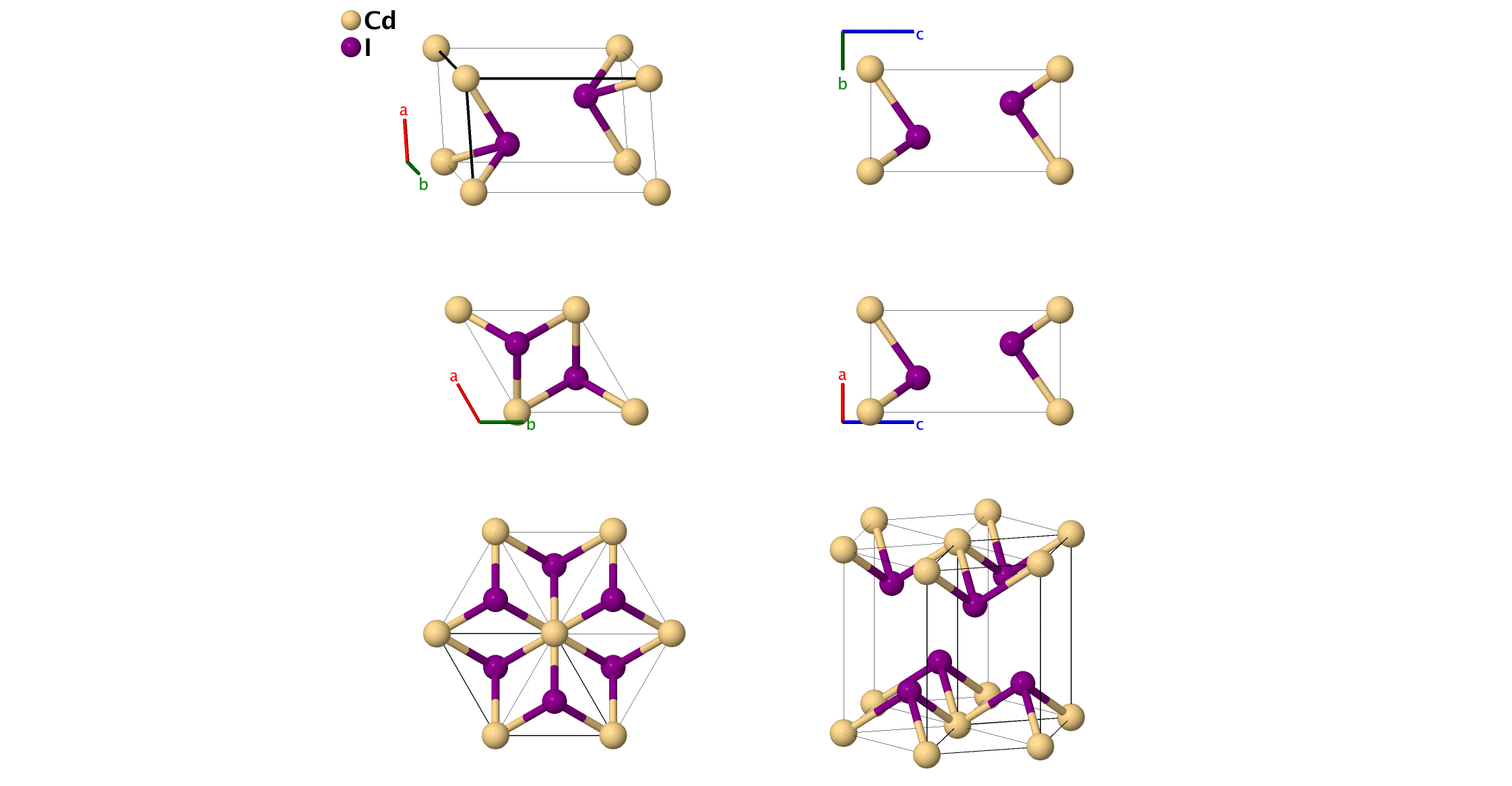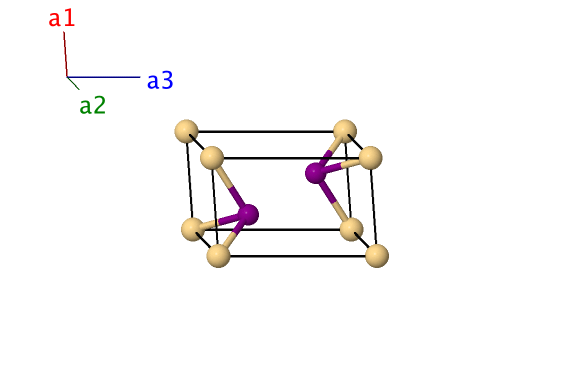
$\omega$ (C6) Phase: AB2_hP3_164_a_d
| Prototype | : | CdI2 |
| AFLOW prototype label | : | AB2_hP3_164_a_d |
| Strukturbericht designation | : | $C6$ |
| Pearson symbol | : | hP3 |
| Space group number | : | 164 |
| Space group symbol | : | $\mbox{P}\bar{3}\mbox{m1}$ |
| AFLOW prototype command | : | aflow --proto=AB2_hP3_164_a_d --params=$a,c/a,z_{2}$ |
Other compounds with this structure
- Ti, Zr, Hf, ZrNb, TiNb, TiV
- The $\omega$ phase can be either hexagonal or trigonal (shown here). The trigonal $\omega$ phase transforms into several high-symmetry structures under certain conditions: \[ \begin{array}{ccc}
\mbox{$\textbf{$c/a$}$} & \mbox{$\textbf{$z$}$} & \mbox{$\textbf{Lattice}$} \\
\mbox{Arbitrary} & 0 & \href{AB2_hP3_191_a_d.html}{\mbox{Ideal Omega (C32)}} \\
\sqrt{\frac{3}{8}} & \frac{1}{6} & \href{A_cI2_229_a.html}{\mbox{Body-Centered Cubic (A2)}} \\
\sqrt{\frac{3}{2}} & \frac{1}{6} & \href{A_cP1_221_a.html}{\mbox{Simple Cubic (A}_{h}\mbox{)}} \\
\sqrt{6} & \frac{1}{6} & \href{A_cF4_225_a.html}{\mbox{Face-Centered Cubic (A1)}} \\
\mbox{Arbitrary} & \frac{1}{2} & \href{A_hP1_191_a.html}{\mbox{Simple Hexagonal Structure (A}_{f}\mbox{)}} \\
\end{array}
\]For more details about the omega phase and materials which form in the omega phase, see (Sikka, 1982) . As noted there, most omega phase intermetallic alloys are disordered. Although the
$\omega$
label comes from $\omega$–CrTi, (Ewald, 1931) lists the prototype for Strukturbericht designation C6 as CdI2.
Trigonal Hexagonal primitive vectors:
\[
\begin{array}{ccc}
\mathbf{a}_1 & = & \frac12 \, a \, \mathbf{\hat{x}} - \frac{\sqrt{3}}{2} \, a \, \mathbf{\hat{y}} \\
\mathbf{a}_2 & = & \frac12 \, a \, \mathbf{\hat{x}} + \frac{\sqrt{3}}{2} \, a \, \mathbf{\hat{y}} \\
\mathbf{a}_3 & = & c \, \mathbf{\hat{z}}\\
\end{array}
\]
Basis vectors:
\[ \begin{array}{ccccccc} & & \mbox{Lattice Coordinates} & & \mbox{Cartesian Coordinates} &\mbox{Wyckoff Position} & \mbox{Atom Type} \\ \mathbf{B}_{1} & = & 0 \, \mathbf{a}_{1} + 0 \, \mathbf{a}_{2} + 0 \, \mathbf{a}_{3} & = & 0 \mathbf{\hat{x}} + 0 \mathbf{\hat{y}} + 0 \mathbf{\hat{z}} & \left(1a\right) & \mbox{Cd} \\ \mathbf{B}_{2} & =& \frac13 \, \mathbf{a}_{1} + \frac23 \, \mathbf{a}_{2} + z_{2} \, \mathbf{a}_{3}& =& \frac12 \, a \, \mathbf{\hat{x}} + \frac1{2\sqrt{3}} \, a \, \mathbf{\hat{y}} +z_{2} \, c \, \mathbf{\hat{z}}& \left(2d\right) & \mbox{I} \\ \mathbf{B}_{3} & =& \frac23 \, \mathbf{a}_{1} + \frac13 \, \mathbf{a}_{2} - z_{2} \, \mathbf{a}_{3}& =& \frac12 \, a \, \mathbf{\hat{x}} - \frac1{2\sqrt{3}} \, a \, \mathbf{\hat{y}} -z_{2} \, c \, \mathbf{\hat{z}}& \left(2d\right) & \mbox{I} \\ \end{array} \]References
- R. M. Bozorth, The Crystal Structure of Cadmium Iodide, J. Am. Chem. Soc. 44, 2232–2236 (1922), doi:10.1021/ja01431a019.
- S. K. Sikka, Y. K. Vohra, and R. Chidambaram, Omega phase in materials, Prog. Mater. Sci. 27, 245–310 (1982), doi:10.1016/0079-6425(82)90002-0.
Found in
- P. P. Ewald and C. Hermann, Strukturbericht Band I, 1913–1928 (Akademsiche Verlagsgesellschaft M. B. H., Leipzig, 1931)., pp. 161-163.
